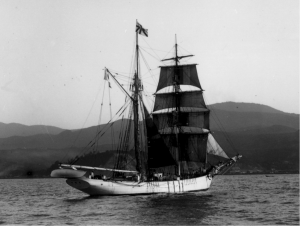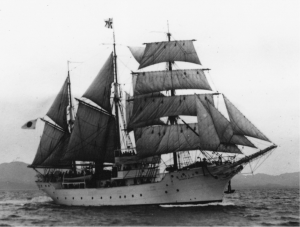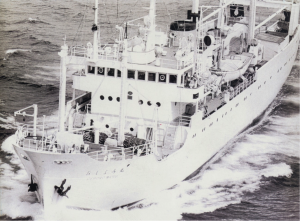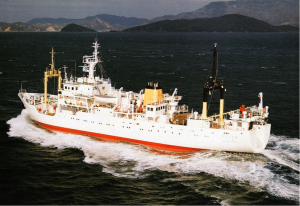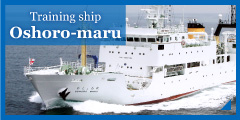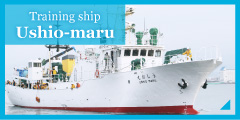T/S Oshoro MaruⅠ
In 1909, the first Oshoro Maru was built after two years later when the School of Fisheries Sciences, Hokkaido University, was founded as the School of Fishery, Sapporo Agriculture College, in February 1907. The 31-meter wooden topsail schooner was modeled after those used in the Gloucester cod fishery and named for a bay located 10 km west of Otaru, Hokkaido. The first Oshoro Maru safely completed its 26th voyage in August 1926 at the age of 18, having traveled around 50,000 nautical sea miles and acted as the ocean fisheries training vessel. After that, the ship was transferred to the Japan Youth Solidarity Union, renamed the Giyuwani-Maru, and used as a marine training vessel.
Kichisaburo Endo, a professor at that time, thought up the name Oshoro Maru, the Dean of the school Sosuke Sato christened the ship Oshoro Maru, which was written with kanji (Chinese characters).
T/S Oshoro Maru Ⅱ
In 1927, the Oshoro Maru I was replaced by the Oshoro Maru II, a 42-meter steel barkentine with a 500-horsepower diesel engine and a complement of 59. Training voyages continued in the Sea of Okhotsk and expanded in 1931 to include trawl surveys in the East China Sea. These voyages continued until World War II, when the ship’s sailing equipment was
removed in 1942, and the ship was used by the Japanese Merchant Marine to transport coke between Hokkaido and Honshu Islands. She was strafed in an air raid by U.S. planes on Hakodate during 14-16 July 1945, but escaped with little damage.
In May 1949, the Oshoro Maru II’s fishing equipment was reinstalled, and training cruises resumed off Japan’s Pacific coast. In 1952, the ship was lengthened to 47 meters, her engine was replaced, and radar equipment was installed; these renovations broadened the ship’s sampling range.
The Oshoro Maru II began summer sampling in the North Pacific in 1953, as one of Japan’s research ships for the International North Pacific Fisheries Commission. Salmon, plankton and hydrographic data were collected in the Northwest Pacific and southern Bering Sea. In 1954, the ship traveled as far as Bristol Bay, where it tied up to a Japanese crab-cannery boat for several hours to let the students observe the processing operations. The visit also allowed crewmen the rare opportunity to bathe. The Oshoro Maru II could carry only 126 cubic meters of freshwater, so during the 50-day cruises with no port calls, the use of freshwater was strictly controlled. Baths were forbidden, and each crewman was allowed to use only enough water to wash his face in the morning. The only chance they had to bathe was during visits to a cannery boat that had a bath.
The Oshoro Maru II was used for the summer North Pacific cruises through 1961. Besides these cruises, she also participated in the International Geophysical Year (1957-58) surveys, and in observations on the 1958 solar eclipse at Suwarrow Atoll in the Cook Islands. During her final cruise in the winter of 1961 to Saigon, the weakening hull began to leak seawater. In 35 years of service, the ship traveled 303,000 miles and was used to train 1,648 students.
T/S Oshoro Maru III
In 1962, the Oshoro Maru II was replaced by the Oshoro Maru III, a 67-m 1,180-ton stern trawler equipped with a 2,000-horsepower engine and a variable-pitch propeller. The ship’s complement numbered 106, including 60 students, 40 crew, and 6 scientists. Her first voyage was to the Indian Ocean to participate in the International Indian Ocean Expedition. She
made her first North Pacific cruise in May 1963, and began carrying aboard foreign scientists during these cruises in 1968; more than 100 U.S. and Canadian scientists have since participated. During her 1972 North Pacific cruise, the ship ventured into the Chukchi Sea as far north as 72oN which set the record for the northernmost cruise by a Japanese ship.
During the 1953-77 North Pacific cruises, the main sampling areas were the Bering Sea and Northwest Pacific, and the core of the sampling program included hydrographic, plankton, fish-larva and salmon drift gillnet sampling. In 1978, the sampling area expanded to include the Subarctic Current and Subarctic Boundary, which became the focus of subsequent
research. Data have been collected on various nekton from this region, including red flying squid, Pacific pomfret, Pacific saury, and albacore. These and other data from the North Pacific cruises have been published annually since 1957 in the Faculty of Fisheries’ “Data Record of Oceanographic Observations and Exploratory Fishing”. The Oshoro Maru III
completed her final cruise in 1983, after sailing nearly 530,000 nautical miles, and carrying 3263 students and 850 scientists, including 144 from foreign countries.
T/S Oshoro Maru Ⅳ
In 1984, she was replaced by the 1,383-ton Oshoro Maru IV, a 73-m stern trawler equipped with a 3,200 horsepower engine. In addition to a trawler-shaped stern and variable pitch bow thruster, the ship is equipped with various types of nautical instruments such as hybrid navigation system, echo sounders, fisheries surveillance equipment including trawl fishing analysis equipment, computers, survey and observation tools, and several types of hydraulic fishing equipment including trawl winch, tuna longline and drift-net. This ship continues to be used today.

